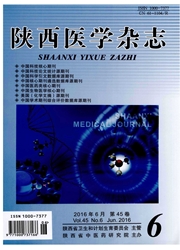

 中文摘要:
中文摘要:
目的:探讨光动力疗法(PDT)对兔耳增生性瘢痕(HS)的治疗作用及其机制。方法:构建兔耳HS模型,将模型分为高浓度光敏剂、低浓度光敏剂、无光敏剂、阴性对照、正常对照5组,观察了PDT对其外观的影响,通过Masson染色观察对HS病理形态的影响,同时通过RT—PCR和ELISA法观察了各组样本MMP-2、MMP-3、MMP-9和TIMP-1蛋白的表达以及β-gal浓度改变。结果:PDT可通过诱导MMPs/TIMPs比例上调,引起成纤维细胞老化,促进胶原蛋白和ECM降解,从而抑制HS的形成,效果持久达60d,适当高浓度的光敏剂疗效更佳。结论:PDT可通过诱导成纤维细胞老化抑制HS的形成,PDT或许成为将来治疗病理性瘢痕的一种理想手段。
 英文摘要:
英文摘要:
Objective: This study sought to investigate the effect of photodynamic on the rabbit ear HS model and its specific mechanism of action. Methods: We constructed the rabbit ear HS model and divided them into 5 groups as high concentration aminolevulinic acid (ALA), low concentration ALA, without ALA, negative and normal control. Then observed the appearance of rabbit ear HS model, investigated its pathological morphology by Masson stain. Furthermore, the mRNA levels of MMP-2, -3, -9, and TIMP-1 in HS tissue were investigated by RT-PCR, and the β-gal concentration were detected by ELISA to confirm the cell senescence. Results: Our data indicated that by increasing the ratio of MMP to TIMP, PDT could accelerate the aging of fibroblasted and promote the degradation of collagen and the extraeellular matrix, thereby inhibiting HS formation with an effect that lasted up to 60 days. The efficacy of the treatment could be maximized by applying an appropriately high concentration of ALA. Conclusions: PDT can induce fibroblasts senescence and might become an ideal treatment for pathological scar.
 同期刊论文项目
同期刊论文项目
 同项目期刊论文
同项目期刊论文
 期刊信息
期刊信息
